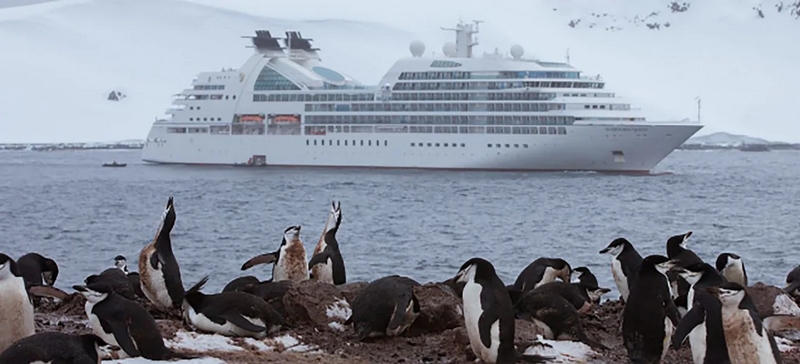
Seabourn The Ultimate Antarctica & Patagonia Experience; @seabourn.com
One of the world’s leading polar explorers has warned against the explosive growth in cruise ship tourism in the Arctic, calling it damaging to both the local environment and its inhabitants.
Arved Fuchs, a German adventurer and the first person to reach both the north and south poles on foot in a year, said: “The number of cruise ships is rising, that’s the crux. And the bigger the ship, the more problematic this is. Party ships have no place in the Arctic,” he told the Neue Osnabrücker Zeitung in an interview.
Fuchs, a celebrated environmentalist who runs an annual climate camp to teach European students about global warming, said he had witnessed small Inuit villages being inundated by day trippers spilling out of cruise ships.
“Some of the small Inuit villages are regularly flooded with cruise ship passengers,” he said. “They do nothing more than gawp and give little back to the people who live there. The visitors are the only ones to profit, not the residents.”
The number of cruise ships operating in the Arctic is on the rise, with major travel companies offering journeys or “expeditions” as they are often marketed, to regions hitherto rarely visited by ordinary tourists, plugging them as “the last true frontiers”, and offering attractions such as the chance to see rare wildlife, spectacular scenery, even melting ice caps.
Tourism industry observers say the region is becoming more attractive as cruise operators face restrictions elsewhere, such as Venice and Dubrovnik, which have recently introduced strict rules governing how many cruise ships can dock. Fears of terrorism in countries such as Turkey or northern Africa have also contributed to an interest in the region.

An investigation into the global rise in cruise ship tourism in the latest edition of the news magazine Der Spiegel expressed concern that the Arctic and Antarctic, once considered out of bounds for cruise liners, largely for logistical reasons, are increasingly being offered as travel destinations.
Annual cruise ship passenger numbers worldwide have risen from 11 million a year in 2009 to 28.5 million in 2018. German passenger numbers have doubled in the past decade, to 2.2 million and are expected to rise almost threefold again in the next decade, to 6 million. Germans, along with Britons, are considered the most enthusiastic cruise ship tourists, according to the magazine. The growth has put particular pressure on operators to seek out newer, exciting destinations, with Greenland and northern Canada considered to be among the favourites.
An estimated 124 new cruise ships – with a capacity of 5,000 passengers or more each – are reported to be under construction or due to be launched in the next few years.
“Travel destinations are now limitless … with people taking cruises to the Antarctic in order to watch the ice caps melting, whilst they sip their prosecco,” Spiegel wrote in its damning front cover article entitled “S.O.S – Crazy Cruises and the Dark Side of the Dream Holiday”. It details the environmental damage caused by cruise liners as well as their operators’ ability to avoid billions of dollars in tax and the need to abide by EU work legislation by registering the ships outside the EU.
On a recent cruise of the Mediterranean by German holidaymakers it found a man from the Philippines working onboard as a cleaner for seven days a week, 10 hours a day to earn $2.81 (£2.32) an hour.
The environmental burden of the average cruise ship is considerable, according to the Centre for High North Logistics which collects data on maritime transport in the Arctic, and estimates that the average cruise ship passenger generates about eight gallons of sewage per day while the average cruise ship churns out more than 95,000 litres of oily bilge from engines and machinery.
Fuchs, who is currently leading a scientific investigation into the amount of plastics in the sea, said he did not want to dampen the recent growth of interest in the polar regions, where dramatic climatic changes were taking place.
“I welcome the fact that this topic is now considered so important. As we see the permafrost is melting, glaciers are melting. Entire settlements are having to be evacuated and resettled elsewhere. In some places the coast is eroding at a rate of up to 16 metres a year.
“The Arctic acts as something like an early warning system. What happens there will later happen elsewhere in the world.”
guardian.co.uk © Guardian News & Media Limited 2010
Published via the Guardian News Feed plugin for WordPress.

